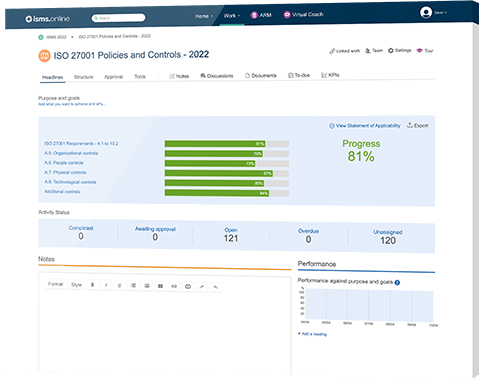
Access to information from internal and external sources is the cornerstone of an organisation’s information security policy.
Control 8.3 is a preventative control that maintains risk by establishing a series of rules and procedures that prevent unauthorised access/misuse of an organisation’s information and ICT assets.
| Control Type | Information Security Properties | Cybersecurity Concepts | Operational Capabilities | Security Domains |
|---|---|---|---|---|
| #Preventive | #Confidentiality #Integrity #Availability | #Protect | #Identity and Access Management | #Protection |
Control 8.3 deals with an organisation’s ability to control access to information.
As such, ownership should reside with the Chief Information Security Officer (or organisational equivalent), who holds responsibility for the organisation’s overall information and data security practices.
In order to maintain effective control over information and ICT assets, and in support of access restriction measures, organisations should ensure the following in line with a topic-specific approach to information access:
Control 8.3 advocates for a dynamic approach to information access.
Dynamic access management has numerous residual benefits for organisational processes that feature the need to share or use internal data with external users, including faster incident resolution times.
Dynamic access management techniques protect a broad range of information types, from standard documents to emails and database information, and have the ability to be applied on a granular file-by-file basis, enabling tight control of data on an organisational level.
Organisation’s should consider such an approach when:
Dynamic access management is of particular use for organisations that need to monitor and protect data from creation through to deletion, including:
All efforts to formulate a dynamic access management approach should result in data being protected by:
27002:2022-8.3 replaces 27002:2013-9.4.1 (Information access restriction), and represents a major shift in how ISO considers information access management in accordance with the aforementioned dynamic approach (a technique that isn’t mentioned in the 27002:2013-9.4.1)
27002:2022-8.3 contains a large amount of guidance notes relating to dynamic access management that are absent from its 2013 counterpart, and organisations are advised to consider these on a topic-by-topic basis, when seeking certification.
ISMS.Online is the leading ISO 27002 management system software that supports compliance with ISO 27002, and helps companies to align their security policies and procedures with the standard.
The cloud-based platform provides a complete set of tools to assist organisations in setting up an information security management system (ISMS) according to ISO 27002.
Our platform has been designed from scratch with the help of information security experts from around the world and we have developed it in a way that makes it easy for people without any technical knowledge about information security management systems (ISMS) to use it.
Get in touch today to book a demo.

We’ll give you an 81% headstart
from the moment you log in
Book your demo
| ISO/IEC 27002:2022 Control Identifier | ISO/IEC 27002:2013 Control Identifier | Control Name |
|---|---|---|
| 5.7 | New | Threat intelligence |
| 5.23 | New | Information security for use of cloud services |
| 5.30 | New | ICT readiness for business continuity |
| 7.4 | New | Physical security monitoring |
| 8.9 | New | Configuration management |
| 8.10 | New | Information deletion |
| 8.11 | New | Data masking |
| 8.12 | New | Data leakage prevention |
| 8.16 | New | Monitoring activities |
| 8.23 | New | Web filtering |
| 8.28 | New | Secure coding |
| ISO/IEC 27002:2022 Control Identifier | ISO/IEC 27002:2013 Control Identifier | Control Name |
|---|---|---|
| 6.1 | 07.1.1 | Screening |
| 6.2 | 07.1.2 | Terms and conditions of employment |
| 6.3 | 07.2.2 | Information security awareness, education and training |
| 6.4 | 07.2.3 | Disciplinary process |
| 6.5 | 07.3.1 | Responsibilities after termination or change of employment |
| 6.6 | 13.2.4 | Confidentiality or non-disclosure agreements |
| 6.7 | 06.2.2 | Remote working |
| 6.8 | 16.1.2, 16.1.3 | Information security event reporting |
| ISO/IEC 27002:2022 Control Identifier | ISO/IEC 27002:2013 Control Identifier | Control Name |
|---|---|---|
| 7.1 | 11.1.1 | Physical security perimeters |
| 7.2 | 11.1.2, 11.1.6 | Physical entry |
| 7.3 | 11.1.3 | Securing offices, rooms and facilities |
| 7.4 | New | Physical security monitoring |
| 7.5 | 11.1.4 | Protecting against physical and environmental threats |
| 7.6 | 11.1.5 | Working in secure areas |
| 7.7 | 11.2.9 | Clear desk and clear screen |
| 7.8 | 11.2.1 | Equipment siting and protection |
| 7.9 | 11.2.6 | Security of assets off-premises |
| 7.10 | 08.3.1, 08.3.2, 08.3.3, 11.2.5 | Storage media |
| 7.11 | 11.2.2 | Supporting utilities |
| 7.12 | 11.2.3 | Cabling security |
| 7.13 | 11.2.4 | Equipment maintenance |
| 7.14 | 11.2.7 | Secure disposal or re-use of equipment |